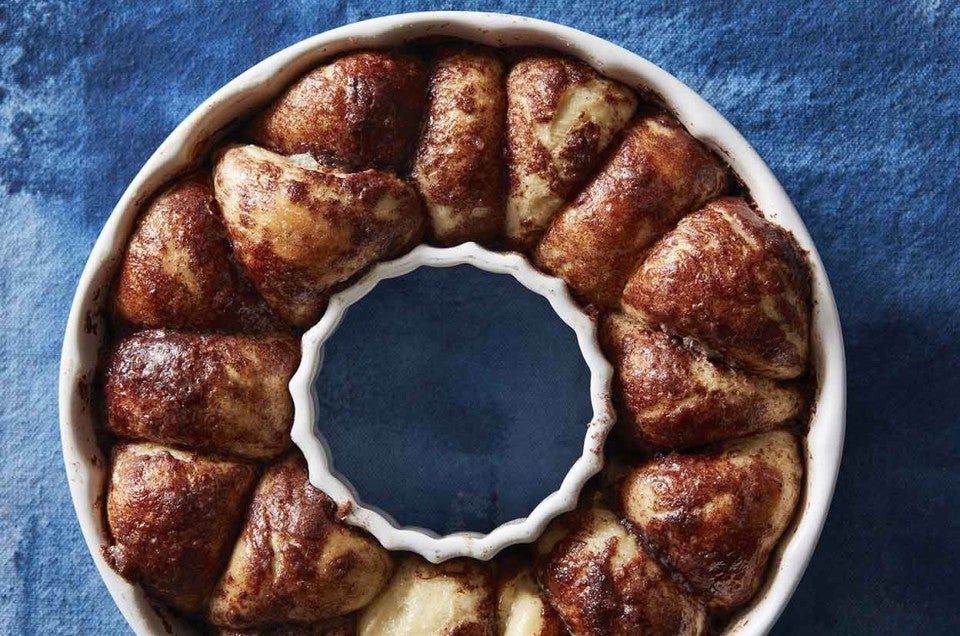


OK, class, today we're going to make cinnamon monkey bread.
Never baked with yeast before?
Read on...
Yeast baking is child's play, really.
In fact, it's the subject of one of the kids' classes we teach at our Baking Education Center here in Norwich, Vermont.
Robyn Sargent, one of our crew of seasoned instructors and a mom herself, teaches a lot of the kids' classes.
Jess Meyers — who used to man our Bakers' Hotline, and now teaches at the school — often pitches in as an assistant when she's not teaching. She's a mom, too. Moms are REALLY good at figuring out what needs to be done, and doing it.
The fun part...
Icing!
The kids took time to decorate their take-home boxes while the bread finished cooling.
...and proudly showed off their loaves, before adding their own wildly colored icings.
Ready to jump in? Know a kid who'd like to help? Monkeying Around Bread is a fun, easy, TASTY introduction to yeast baking.
Let's start with the topping/filling. Mix 1/2 cup (99g) granulated sugar and 1 tablespoon cinnamon till thoroughly combined. Best way?
Shake it up, baby. Here we've used a covered yogurt container.
It does a good job, eh? A few shakes is all it takes; much faster than a fork or whisk and bowl.
Next, we'll make the dough. Combine 1/2 cup (113g) lukewarm water, 2 teaspoons instant yeast, 1 tablespoon vegetable oil, 1 large egg, 1 teaspoon salt, and 1 tablespoon granulated sugar.
Whisk till well combined.
You're going to add 2 cups (241g) King Arthur Unbleached All-Purpose Flour, but not all at once. Add 1 cup to start.
Stir to combine...
Then add the other cup.
Stir to make a cohesive dough.
Next, you're going to knead the dough. You can do this by hand, but in the test kitchen we're always in a hurry and have about three things going at once, so we used a stand mixer or bread machine to knead dough.
First, mix the dough for 1 minute, using the beater attachment.
Scrape the sticky dough from the sides of the bowl. Let it rest for 5 minutes; this gives the flour a chance to absorb the liquid, which will make kneading easier and smooth the dough out more quickly.
Knead for 7 minutes, using the dough hook. Notice how it still sticks a little bit to the sides of the bowl; that's OK. Up to a point, the stickier your dough, the higher-rising and moister your bread.
Now we're going to let the dough rise. I'm spraying an 8-cup measure with non-stick vegetable oil spray, so the dough doesn't stick. Everbake is our test-kitchen favorite. We use it for everything; it's especially good for pans, as it doesn't make your pans all tacky and dark, like some sprays do.
Put the dough into the container, patting it down gently. Be sure to put a cover on the container, so it doesn't dry out. A (non-soapy!) shower cap works well here.
Let the dough rise for 30 to 60 minutes, till it's grown to about twice its size.
Next step: spray an 8” cake pan with non-stick vegetable oil spray. Here's the Everbake at work again.
Spray your clean work surface, too. I'm using a silicone mat here, which keeps your counter from getting all full of flour and cinnamon and stuff. When I'm done, I just take it to the sink and rinse it off – certainly makes cleanup a snap.
Have a bowl of water, and your bowl of cinnamon-sugar ready.
Take your dough, and put it onto your lightly greased work surface. No need to consciously deflate it; it'll deflate itself a bit as you move it around. Pinch off pieces about 1 1/2” in diameter.
Don't worry too much here; the pieces can actually be whatever size you want. But 1 1/2” is a good, medium-range size.
Dip the piece of dough in the water...
...then roll it around in the cinnamon-sugar. Place it in the pan.
You can make all the balls first, if you like, then dip them.
Here they are in the pan.
If you have cinnamon-sugar left over, sprinkle it over the dough balls.
Like this.
Cover the pan. There's that shower cap again!
Let the dough balls rise, again for about 30 to 60 minutes, till they're noticeably puffy. Toward the end of the rising time, preheat your oven to 350°F.
Bake the buns (uncovered) for 25 to 30 minutes, till they feel set. When you poke one, it shouldn't feel soggy. Toward the end of the baking time, get out a cooling rack, and set it on the counter.
Remove the monkey bread from the oven. Working quickly...
Turn the pan over, onto the rack. Lift the pan off. If there's any sticky syrup in the bottom of the pan, use a spatula to scrape it onto the buns.
As soon as the bread is cool enough not to burn your fingers, pull it apart.
Or, Plan B: Do like the kids at our Baking Education Center do. Let it cool completely, turn right side up, and drizzle with confectioners' sugar icing — wild colors optional.
Read, rate, and review (please!) our recipe for Monkeying Around Bread.

